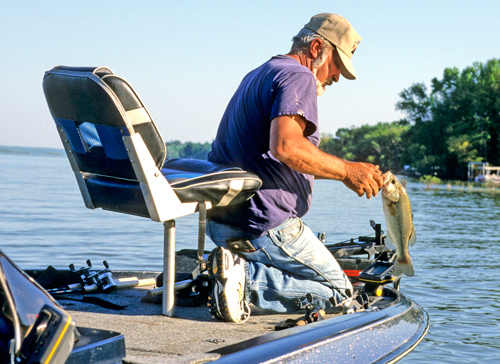By Lee McClellan
FRANKFORT, Ky. – The wet and unseasonably cool weather pattern lately seems more consistent with Derby week than the with the upcoming Fourth of July holiday.
Chris Hickey, black bass research biologist for the Kentucky Department of Fish and Wildlife Resources, said the cool weather delayed the largemouth bass spawn a couple of weeks, but now everything is on schedule as we head into the heat of summer.

He said anglers report largemouth bass gathering on the channel ledges on Kentucky and Barkley lakes.
Summer fishing for largemouth bass frustrates many anglers, although anglers themselves are usually the source of the problem. The anglers often don’t much change the presentation or places they fish from the spring season, although their summer catch often consists of a few small male “buck” bass.
Forget fishing the visible cover along the bank and instead concentrate on off-shore structures such as channel ledges, submerged islands, humps and long points to catch bass during the day in July and August. Map study of the underwater features reveals these fish-holding structures. Anglers should plan on probing several during a day of fishing.
“I look for three things for deep ledge fishing,” said Ryan Oster, federal aid coordinator for the fisheries division of Kentucky Fish and Wildlife. “The first is the presence of bait, second is stumps and third is current. Mussel beds on the ledge are also a big help.”
Oster, formerly western fisheries district biologist who helped manage Kentucky and Barkley lakes, prefers deep running crankbaits, 7- to 10-inch straight-tailed worms rigged on Shakey heads and heavy football jig and trailer combinations to fish ledges from 12- to- 25 feet deep on these lakes.
“I like the Sexy Shad color for clear water and the chartreuse Sexy Shad for stained water in my deep crankbaits,” Oster said. “Typically, they want it raking across the bottom. On some days, they want a slow and steady retrieve and on others, they want it fast. Mix it up until they hit.”
Boat positioning is important to keep these lures crawling on the bottom across those underwater ledges and humps. Some anglers use marker buoys to visualize the ledge or hump.
Slowly crawl a Shakey head rig along the bottom, stop it every few feet and shake the rod tip to wiggle the worm and entice bass. Anglers fishing jigs may also work the bottom, but many “stroke” a heavy football jig by ripping it off the bottom with their rod tip and letting the lure fall on a slack line. Trophy largemouths often hit the jig on the fall.
Use at least ½-ounce of weight to get down on the deep structure. Many opt for ¾-ounce or 1-ounce jigs. Shakey worms in green pumpkin, black or purple work well in deep water. Black jigs in combination with blue, purple, brown or chartreuse produce deep bass.
During the hottest times of the year, largemouth bass suspend over the ledge or hump and ignore lures worked on bottom. A swimbait works well for suspended bass.
Pearl-colored swimbaits with shades of gray, blue and light purple work well. Fish the swimbait just above bottom rigged on a ¼-ounce or 3/8-ounce head as heavier heads deadens the lure’s action. Oster prefers 5-inch swimbaits.
Points that extend well out into the lake are high percentage spots for summer largemouth bass. Jigs slowly crawled across the point in water 15- to 25-feet deep draws strikes. Points with stumps or chunk rock on them hold the most fish.
The best ledge fishing is on Kentucky Lake, Lake Barkley and Barren River Lake. Most lakes across Kentucky have long extended points and many have underwater humps.
Get off the bank and catch huge bass on the hottest days.
Author Lee McClellan is an award-winning associate editor for Kentucky Afield magazine, the official publication of the Kentucky Department of Fish and Wildlife Resources. He is a life-long hunter and angler, with a passion for smallmouth bass fishing.
-30-
The Kentucky Department of Fish and Wildlife Resources manages, regulates, enforces and promotes responsible use of all fish and wildlife species, their habitats, public wildlife areas and waterways for the benefit of those resources and for public enjoyment. Kentucky Fish and Wildlife is an agency of the Tourism, Arts and Heritage Cabinet. For more information on the department, visit our website at fw.ky.gov.


Be the first to comment